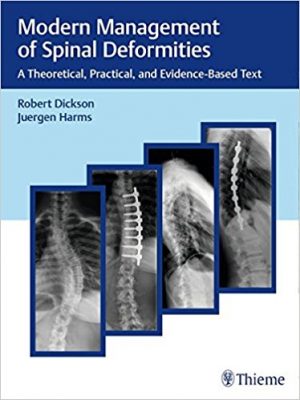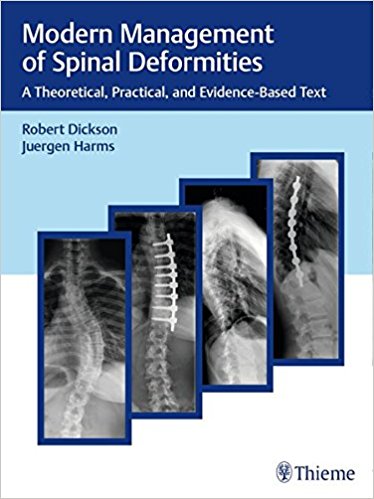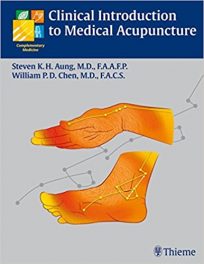 Authors: Robert Dickson, ChM; and Juergen Harms, MD
Authors: Robert Dickson, ChM; and Juergen Harms, MD
Publisher: Thieme – 314 pages, with 935 illustrations
Book Review by: Nano Khilnani
This large (8.25”x11”) book of over 300 pages having 900+ images – well-captioned black-and-white radiographs, full-color photos of patients, charts, drawings, sketches and tables – provides a larger amount lot of information visually than through written words. Most of the illustrations are ample in size, capturing the reader’s attention immediately as he or she turns to that page.
This lengthy work is the fruit of a labor of love by only two spine specialists functioning as editors and authors, with no contributors at all. But they are highly proficient surgeons with many years spent in medical education, training, practice, teaching and mentoring others who entered their field. See their resumes on pages xv and xvi.
This book covers numerous topics within the subject of spinal deformities in each chapter, but space permits us to name only the titles of its 11 chapters. We list below to provide you a broad perspective of its immense coverage:
- The Beginnings of Surgery for Spinal Deformities
- Basic Principles
- The Etiology of Spinal Deformities
- Idiopathic Scoliosis
- Scheuermann’s Disease
- Congenital Deformities
- Neuromuscular Deformities
- Deformities Associated with Neurofibromatosis
- Spinal Deformities Due to Tumors
- Miscellaneous Conditions Associated with Spine Deformities
- Spondylolysis and Spondylolisthesis
In their Preface, Drs. Robert Dickson and Juergen Harms state that since the turn of the century, knowledge about spinal deformities and treatments has increased tremendously. And in the last 10 years (since around 2008) there has been an exponential growth in the variety of procedures and instrumentation that can be done for all types of deformities of the spine.
They make this important point: “It is the what, the why, and the when, rather than the how that are the most important factors governing safe and competent practice, so we all the while emphasize these points throughout the text.”
A common type of spinal deformities is scoliosis (from the Greek tern skoliosis meaning ‘bending’), a medical condition wherein a spine is curved laterally (sideways) like an ‘S’ or a ‘C. In some people the curve is static, while in others the curve increases over time. Mild scoliosis usually does not cause problems, but in severe cases it can interfere with breathing.
The cause of most cases of scoliosis is unknown. It is believed that there are genetic causes but no widespread study has been done on this matter. Scoliosis can occur due to cerebral palsy, Marfan syndrome, muscle spasms, and tumors such as neurofibromatosis.
Another well-known deformity of the spine is kyphosis, which is an excessive inward concave curving in the cervical, thoracic, and lumbar portions of the spine. Normally the thoracic spine has a curvature of 25 to 45 degrees from the 1st to the 12th vertebra. When this ‘roundness’ increases to 46 degrees or more, this condition is termed ‘kyphosis’ which in everyday language is called a ‘humpback’ or a ‘hunchback’.
Most kyphotic cases are mild and require only monitoring, but patients with severely curved spines can experience a range of some discomfort to severe pain, eventually requiring surgery to correct the curving, and hopefully, have an erect, vertical posture.
Detailed coverage of spinal deformities in general and idiopathic scoliosis in particular are provided in chapters 3 and 4 of this book. A lot of information on spine-related conditions is also provided in these chapters, as well as in the rest of this extraordinary text, a must-have for practicing and intending orthopedic surgeons.
Editors:
Robert Dickson, ChM is Emeritus Professor of Orthopedic Surgery and Consultant Spinal Surgeon at the University of Leeds, in Leeds in the United Kingdom
Juergen Harms, MD is Professor of Orthopedic Surgery, and is a specialist in Spine Surgery at the Ethianum Clinic in Heidelberg, Germany.







